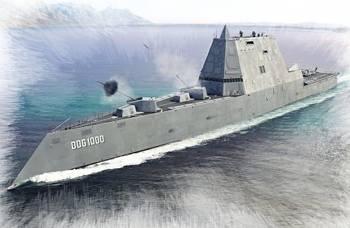
Modern Naval Encyclopedia (1990-…)
Since the end of the cold war and of the USSR until now (as this article is written), in 2020, thirty years has passed. Thirty years combined with moore’s law over computing power and technological evolution made ships more autonomous, and with more capabilities, while budgets were reduced, especially in Europe while they jumped in Asia and were maintained high with a flurry of new operational concepts in the USN, such as the Zumwalt class DDGs, Gerald R. Ford-class nuclear-powered aircraft carriers, Littoral Combat Ship (Freedom-class and Independence-class). Over it lurked the shadow of a completely new Chinese Navy, almost completed overnight, the largest, fastest fleet expansion since the Reichsmarine in 1900 and probably a deciding factors in shifting geopolitics for the first quarter of a century.
New geopolitics
The end of the cold war could have led to the disruption and dissolution of NATO. But it never happened. Well embedded already with the EU’ own organizational schemes to compensate for the lack of Integrated European Defence and even grew with the arrival of new members such as Poland and Romania, the Czech Republic, Hungary… So the “Atlantic” military alliance is framing now basically European and “Western” defence as a whole.
However in recent news appeared the state of unpreparedness of European defence, especially the German Land component and lack of true will and commitment of the Western Europeans in general to create a true military organization inside the EU. Renewal of the European fleets also mirrored these new, more budget-constrained naval policies, although the will is there to keep an edge on International affairs, as showed by the joint intervention of the French and Royal Navy in South China sea and 2000s acquisitions of capital ships such as the Charles de Gaulle (2001) and the Queen Elisabeth (2016).
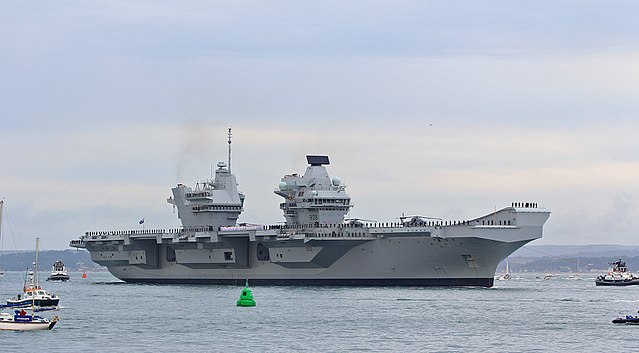
NATO combined naval forces:
On the organizational level, NATO military command structure integrates the Headquarters Allied Maritime Command HQ is based at Northwood, GB.
And comprises as of today the:
- Standing NATO Maritime Groups
- Standing NATO Maritime Group 1 (SNMG1)
- Standing NATO Maritime Group 2 (SNMG2)
- Standing NATO Mine Countermeasures Group 1 (SNMCMG1)
- Standing NATO Mine Countermeasures Group 2 (SNMCMG2)
- MARCOM Subordinate Commands
- NATO Maritime Air Command (COMMARAIR)
- NATO Submarine Command (COMSUBNATO)
- NATO Shipping Centre
Under the Rapidly Deployable Corps Headquarters (HQ based in UK) there are rapid reaction forces from seven countries, while under the SACEUR is placed a naval component called the Naval Striking and Support Forces, also STRIKFORNATO based in Lisbon, Portugal.
Under the Allied Command Transformation (ACT), is placed the Maritime Interdiction Operational Training Center (NMIOTC) in Souda Naval Base, Crete.
Also NATO comprised accredited centers of excellence, among which are the Combined Joint Operations from the Sea (CJOS). Specialist organizations such as the Military Oceanography (MILOC) Group, Military Committee Meteorological Group (MCMG) but also inter-services organisms such as the NATO Electronic Warfare Advisory Committee (NEWAC) or those attached to the mastery of the air and command-control.
NATO critics
It is difficult to have a clear picture of the organization flexibility and reactivity in case of the worst scenario, a concerted attack of Russia and China with an isolationist USA. Combined exercises has been done on a regular basis, despite post-cold war budgetary limitations. Fortunately after the Lisbon Summit in November 2010, NATO leaders agreed on a new Strategic Concept for in a process of continual reform, with the goal of to streamlining structures and improving working methods to maximise efficiency in case of a major crisis.
Rapid intervention against localized threats, mostly post-2001 terrorist threats has been a multi-national military affair with more or less intervention and endorsement by NATO and the UN. However on the naval plan, the military ambitions of China and first-class navy to achieve local hegemony is quite a challenge for the western organization which was tailored first and foremost to answer a Soviet threat. There comes SEATO.
SEATO: A failed Asian match
SEATO as its name suggests is the equivalent of NATO in the Asia-Pacific region. Called Southeast Asian Treaty Organization it was suggested by president Eisenhower in 1954 and set in place at the Manila Pact, and ran until 1977, where it was dissolved. Outside the usual Western leaders such as USA, France and UK which had interests in the region, the alliance comprised Australia, NZ, and more crucially Thailand just after the end of the war of the name against the French at the treaty of Paris, the Philippines, Indonesia (then neutral).
It was headquartered at Bangkok, Thailand and aimed as a counterweight to Communist China (and later communist North Vietnam and North Korea). But because internal disagreements, few exercises took place and most of its member nations contributed very little to the alliance. In fact after the Sino-Soviet split, and in 1969 a rapprochement of China to the west, plus the end of the Vietnam war the context had changed dramatically for SEATO and focus came bask to USSR and NATO.
In fact if the organization’s military side was a failure, its civilian side, SEATO’s Committee of Information, Culture, Education, and Labor Activities, were a success that endures to this day under other names and forms. Nowadays ASEAN (Association of Southeast Asian Nations) is its contemporary inheritor, but comprises communist countries and mostly aimed at civilian cooperation.

ASEAN in 2015.
ASEAN naval policy
Of course with the recent grow of the Chinese PLAN and growing, obvious ambitions in particular in the south China sea, it was difficult not for ASEAN to develop some form of military cooperation, more so with the recent, arguably more isolationist policy of Donald Trump. Even if USN disengagement of the south pacific area is not a priority, the development of substantial naval forces of Thailand, South Korea, Japan, Indonesia among others justify a close cooperation, which traduced now into naval exercizes.
The Association of Southeast Asian Nations (ASEAN) which comprises in addition to the countries already mentioned (but the exclusion of South Korea and Japan which had their own cooperation treaties with the US) Malaysia, the Philippines and Singapore, indeed went beyond their classical naval missions of coastal defence, exclusion zone, fishing areas, and safe passage of trade. However these nations grew preoccupied of new concepts in the sea law as each is now entitled to claim extended exclusive economic zones (EEZs) on continental shelves, with overlapping areas. Combating piracy and smugglers are also now perceived as a global problem and new patrol functions has to be setup to cover offshore resources and ensure the respect of new extended maritime areas.
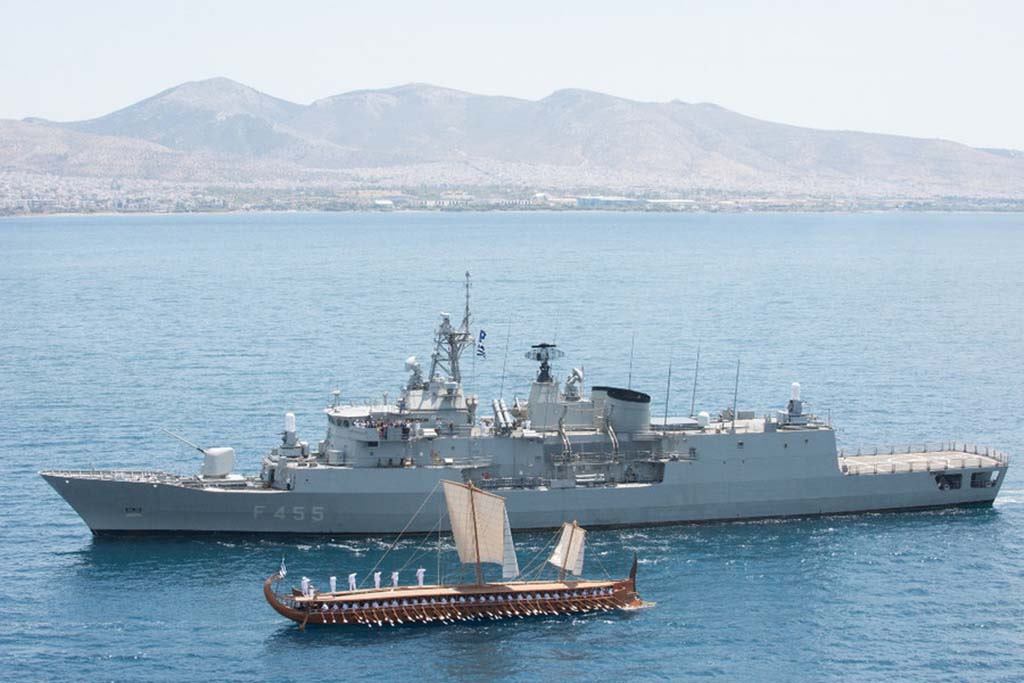
The Hellenic Navy yesterday and now
On the other hand, the large naval exercise that was announced in October 2018 and took place in 2019 was proposed by China and integrated both China, the ASEAN and the US in order to ease relations between the two superpowers in the region. This joint naval drill will be followed by another in 2020. “ASEAN has always tried to walk the tight rope between the two great powers, US and China,” said William Choong, Asia Pacific security analyst from London-based research institution the International Institute for Strategic Studies.
It is important here to underline the absence in these exercises by the other major naval forces of the Asiatic region at large: The Indian, Japanese and South Korean navies. Although the last two have somewhat privileged relations with the US and already conducts joint naval drills for dozens of years, the Indian Navy always has been staunchly neutral, which also traduced in its choices of military procurements, but her past war with China means the perceived threat is real. Therefore Indian attempted a rapprochement with the organisation, seeking an India-ASEAN strategic partnership (with China’s disapproval). Interests well understood by the presence near Vietnam of exploring hydrocarbon resources with ONGC Videsh Ltd. (OVL).
Navies of the world
Postwar decolonization bring on the world scene a whole range of new countries but also a succession of proxies and civil wars redrawing the maps during this era. The cold war ended in 1990 and the world’s map seems now solidly setup. With growing tensions in Asia and in the Middle east, the analysis of modern fleet is more than ever important and could bring some enlightenment to modern conflicts, issues and forces balance, or doing some prospective.
The US Navy Today
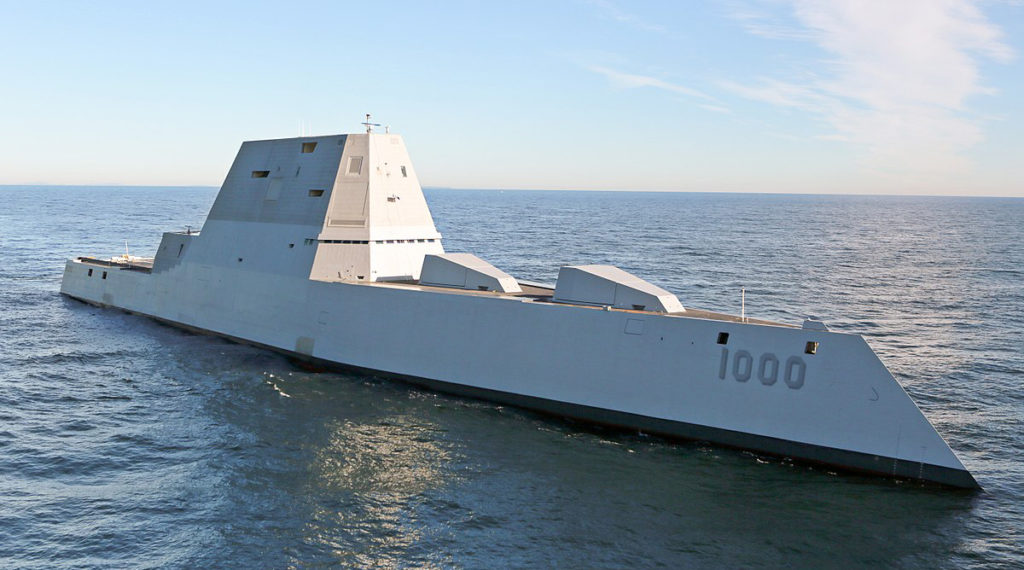
The end of the cold war did bring significant changes, especially in the renewal of the massive “park” of USN ships. Perhaps the only one not changing that much was the Arleigh Burke class destroyers, started in the 1980s and with an ongoing construction in updated batches. Ticonderoga class cruisers, Nimitz class aircraft carriers are also still active. But there were new entries as well, including very innovative ships, somewhat experimental, that were postponed, such as the superlative Zumwalt class destroyers, LCS-1 and LCS-2 (Littoral Combat Ship) and the new Gerald R. Ford class class aircraft carriers, knowing there is a Navy Requirement need for a minimum of 11 aircraft carriers. Also there is an ongoing program for a new Frigate, open to international competition for the design, as none is service today since the O.H. Perry. There is also the continuation of the brand new Virginia class SSNs.
To add to this, the current president Trump expressed the will for the USN to reach 500 active ships (431 today, which on the ships numbers alone made the USN world’s 3rd). The main threat today being the rapid rise of the Chinese Navy and credible presence in Asia. Nevertheless, the USN is still number one, with the same policy as the Royal Navy back one century earlier: Being twice as large as the second world’s largest navy, or the two next best navies combined.
For details, check the excellent sites naval analyses (for modern fleets and surface ships) and covertshores.com more specifically for submarines and spec-ops vessels.
The Chinese PLAN
The Chinese Navy today, fuelled by a strong political will since the 1980s, is easily the second world’s largest, now with two aircraft carriers in service, one of a 100% domestic design, and more in construction. Beijing’s policy indeed clearly mention the goal of four task forces in 2025-30. To defend them, scores of modern missile destroyers and frigates also exited its yards over two decades, and the PLAN made a radical built-up of its nuclear deterrence naval component, with the goal of two classes of modern SSBNs and the SSNs to protect them and patrol in Asia. From perhaps the 11th or 12th rank in 1990, the PLAN is now the second world’s largest navy, driven by bold ambitions and a rather aggressive expansion policy, the number one concerns for the Pentagon after the Middle East. On the ships number bases alone (not tonnage), the PLAN is the world’s second largest with 714 vessels. However most of these are low-tonnage defence FACs, minesweepers and patrol boats. As of 2017 the Navy boasted 2 aircraft carriers, 50 frigates, 29 destroyers, 39 corvettes, 73 submarines, 220 patrol craft, and 29 mine-warfare vessels.
Hot potato: The North Korean Navy
Insignificant during the cold war, this navy was reinforced recently, but surprisingly its the world’s largest fleet with 967 ships. To be fair, the immense majority as small FACs, torpedo or missile vessels and patrol crafts. The North Korean Navy is definitely a green water navy. As of 2017 it boasted 10 frigates, two corvettes, 86 submarines, 438 patrol craft, and 25 mine-warfare vessels.
Read More
https://www.nato.int/cps/en/natohq/structure.htm
https://www.businessinsider.fr/us/biggest-navies-in-the-world-2018-4
Pdf – SEATO naval policy until 1965
https://en.wikipedia.org/wiki/List_of_naval_ship_classes_in_service
ASEAN navies: new missions and old problems Author links open overlay panel – Joseph R.Morgan
ASEAN naval drills on mindef.gov.sg
orfonline.org: india-ASEAN naval cooperation strategy
ASEAN naval exercizes on worldview.stratfor.com
An article of the nytimes.com about the new missile defense systems of the US and Russia
Naval News
The USN Choice of their new frigate (FF-X) 04/05/2020
The three-years long FF(X) program of the US Navy has reached its conclusion: The Italian FREMM design was chosen for the future (2021) American standard US Navy Frigates for a total order of 30 to be delivered in 2027 with a service expectancy of 40 years or so, which brings these to 2060.
This was all for the replacement program for the discarded 1970s OH. Perry class was to be fulfilled by new generation, futuristic and very innovative vessels, the LCS or Littoral Combat Ships.
But like the Zumwalt class DDs none had achieved the expected capabilities as most of their promising modules has been difficult to put into service. Nearly ten years later, amidst astronomical costs the US Navy was forced to curtail the orders to just 17 LCS of both types (Freedom-class ships and Independence-class), for 35 initially planned in 2019, and three Zumwalt-class.
A Navy communique stated it needed “a true frigate”, whereas it was announced to retired the 2008-2012 ships, first four LCS ships in 2021 as part of a cost-savings measure…
The choice of the FREMM, one of the six competitors, was not that a surprise, although non-US builders are traditionally less likely to win thee competitions as history of procurement has proven time and again.
But the Fincantieri design has advantages. The least was not one of its subsidiaries was based in the US, no other than Marinette Marine which already built the LCS. With orders likely to be cancelled, not loosing jobs and saving the company, the building of modified FREMM instead, was a saving grace.
The design of the 2010s multi-mission frigates, a joint-venture between France and Italy also exported to Morocco and Egypt has proven modular, declined into AA, AASW and ASW variants. The US model would be larger, over 8000 tonnes than its European counterparts, and armed entirely with specific US systems, and comprehensive sensor modifications, notably a variation of the AEGIS instead of the radar mack of the Italian FREMM. In service they are called the Aquitaine class (6, +2 construction) and Bergamini class (10). The French first five are ASW vessels, the lest two AA. The Italians built six general purpose and four ASW frigates; No doubt the general purpose models seduced the commission by their versatility.
Read More
Launch of PPA Francesco Morosini 25/05/2020
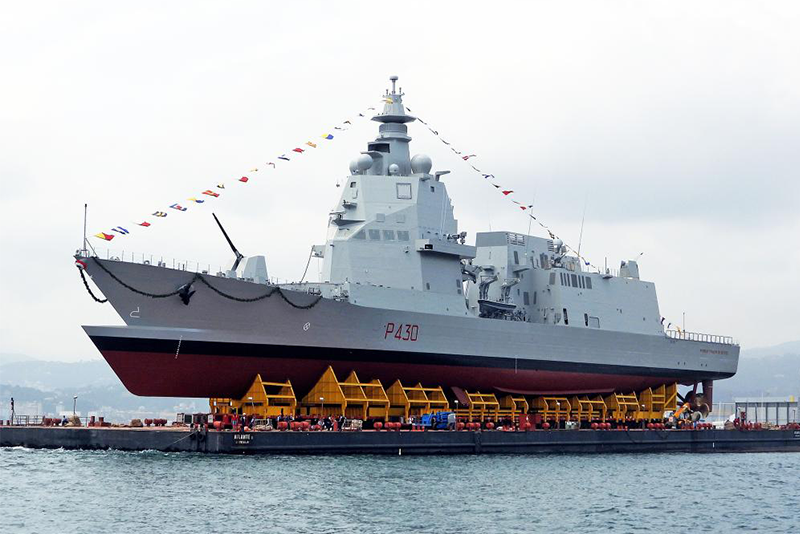
Paolo Thaon di Revel, Muggiano – La Spezia, Italy. – src: armada international.
The Italian corvette launched by Fincantieri, the second of the Paolo Thaon di Revel class is characterized by a very peculiar double bow with a “cutter”. This designed is a very optimized one to save fuel cost consumption and improve seakeeping and speed. Ten are in order so far, the first being laid down in May 2017. At 5000 tonnes and 143 m long they are already large for corvettes, and versatile, armed with a 127 mm main gun, one 76 mm, two Oto Melara Oerlikon KBA B06 SAMs, and a variety of modular armaments, for example 2 x 8-cell DCNS SYLVER A70 VLS for 16 Aster 15, 30 or 30B1NT or Scalp Naval or FFBNW for 2 x 8-cell DCNS SYLVER A70 VLS for 32 CAMM-ER or up to 16 Scalp Naval missiles, and 8 Teseo\Otomat Mk-2/E anti-ship and land attack missiles and 2 x triple WASS B-515/3 launcher for Black Arrow 324 mm torpedoes for ASW warfare plus two SH90 or a single AW101 helicopters.

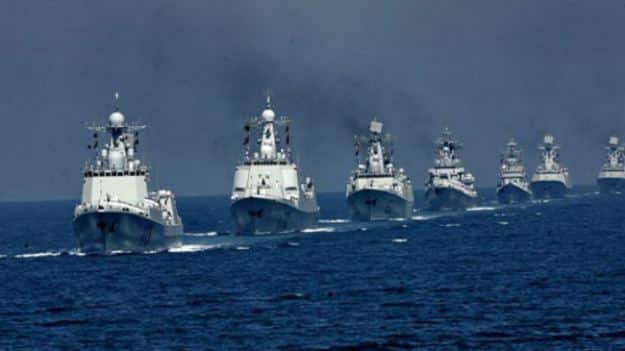
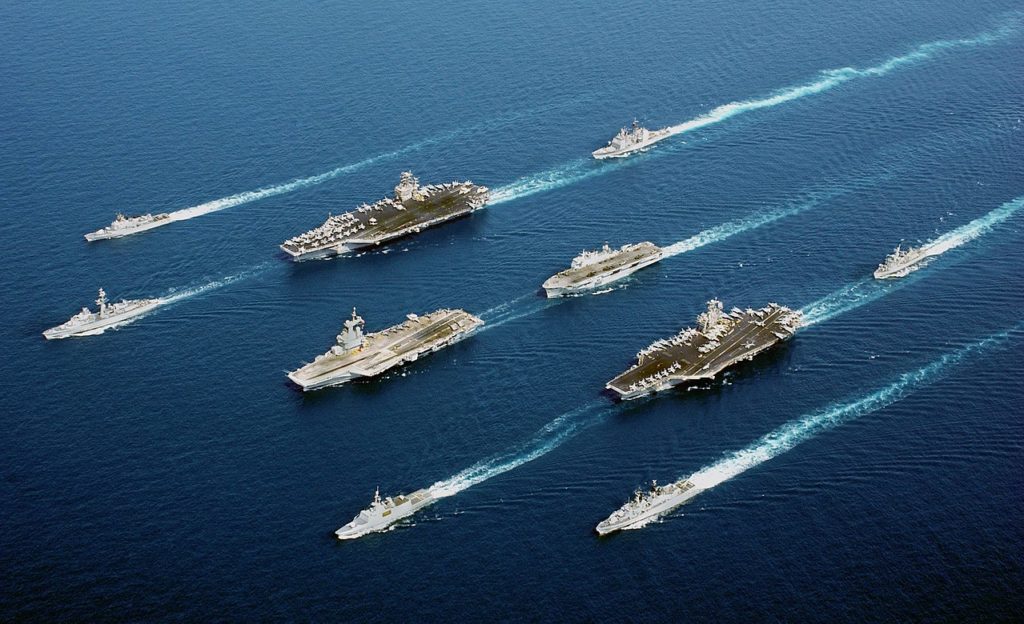
 Latest Facebook Entry -
Latest Facebook Entry -  X(Tweeter) Naval Encyclopedia's deck archive
X(Tweeter) Naval Encyclopedia's deck archive Instagram (@navalencyc)
Instagram (@navalencyc)





 French Navy
French Navy Royal Navy
Royal Navy Russian Navy
Russian Navy Armada Espanola
Armada Espanola Austrian Navy
Austrian Navy K.u.K. Kriegsmarine
K.u.K. Kriegsmarine Dansk Marine
Dansk Marine Nautiko Hellenon
Nautiko Hellenon Koninklije Marine 1870
Koninklije Marine 1870 Marinha do Brasil
Marinha do Brasil Osmanlı Donanması
Osmanlı Donanması Marina Do Peru
Marina Do Peru Marinha do Portugal
Marinha do Portugal Regia Marina 1870
Regia Marina 1870 Nihhon Kaigun 1870
Nihhon Kaigun 1870 Preußische Marine 1870
Preußische Marine 1870 Russkiy Flot 1870
Russkiy Flot 1870 Svenska marinen
Svenska marinen Søværnet
Søværnet Union Navy
Union Navy Confederate Navy
Confederate Navy Armada de Argentina
Armada de Argentina Imperial Chinese Navy
Imperial Chinese Navy Marinha do Portugal
Marinha do Portugal Mexico
Mexico Kaiserliche Marine
Kaiserliche Marine 1898 US Navy
1898 US Navy Sovietskiy Flot
Sovietskiy Flot Royal Canadian Navy
Royal Canadian Navy Royal Australian Navy
Royal Australian Navy RNZN Fleet
RNZN Fleet Chinese Navy 1937
Chinese Navy 1937 Kriegsmarine
Kriegsmarine Chilean Navy
Chilean Navy Danish Navy
Danish Navy Finnish Navy
Finnish Navy Hellenic Navy
Hellenic Navy Polish Navy
Polish Navy Romanian Navy
Romanian Navy Turkish Navy
Turkish Navy Royal Yugoslav Navy
Royal Yugoslav Navy Royal Thai Navy
Royal Thai Navy Minor Navies
Minor Navies Albania
Albania Austria
Austria Belgium
Belgium Columbia
Columbia Costa Rica
Costa Rica Cuba
Cuba Czechoslovakia
Czechoslovakia Dominican Republic
Dominican Republic Haiti
Haiti Hungary
Hungary Honduras
Honduras Estonia
Estonia Iceland
Iceland Eire
Eire Equador
Equador Iran
Iran Iraq
Iraq Latvia
Latvia Liberia
Liberia Lithuania
Lithuania Mandchukuo
Mandchukuo Morocco
Morocco Nicaragua
Nicaragua Persia
Persia San Salvador
San Salvador Sarawak
Sarawak Uruguay
Uruguay Venezuela
Venezuela Zanzibar
Zanzibar Warsaw Pact Navies
Warsaw Pact Navies Bulgaria
Bulgaria Hungary
Hungary

 Bundesmarine
Bundesmarine Dutch Navy
Dutch Navy Hellenic Navy
Hellenic Navy Marina Militare
Marina Militare Yugoslav Navy
Yugoslav Navy Chinese Navy
Chinese Navy Indian Navy
Indian Navy Indonesian Navy
Indonesian Navy JMSDF
JMSDF North Korean Navy
North Korean Navy Pakistani Navy
Pakistani Navy Philippines Navy
Philippines Navy ROKN
ROKN Rep. of Singapore Navy
Rep. of Singapore Navy Taiwanese Navy
Taiwanese Navy IDF Navy
IDF Navy Saudi Navy
Saudi Navy Royal New Zealand Navy
Royal New Zealand Navy Egyptian Navy
Egyptian Navy South African Navy
South African Navy






























 Ukrainian Navy
Ukrainian Navy dbodesign
dbodesign